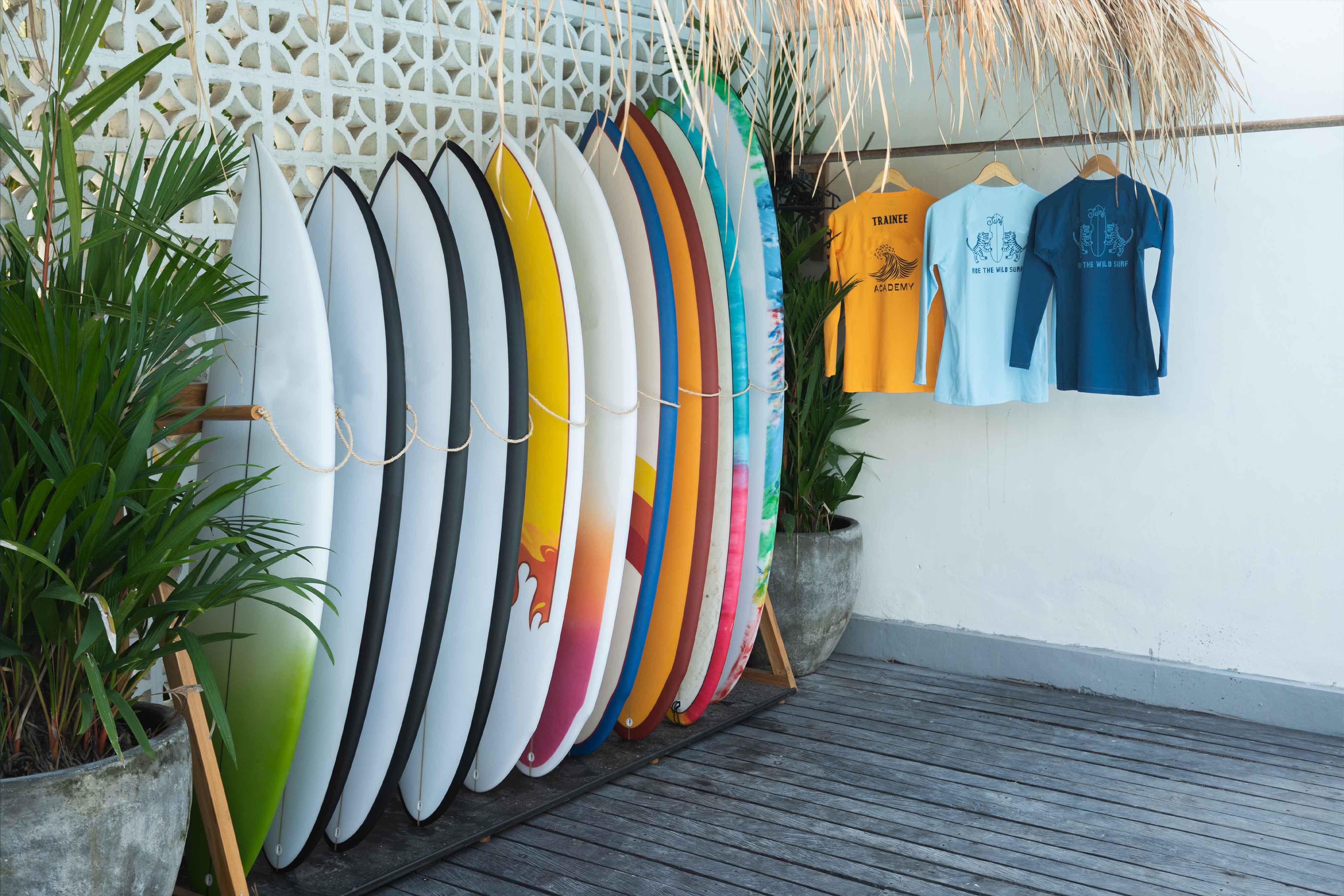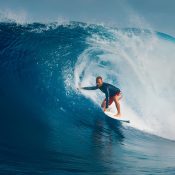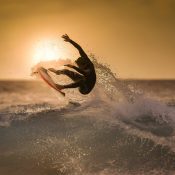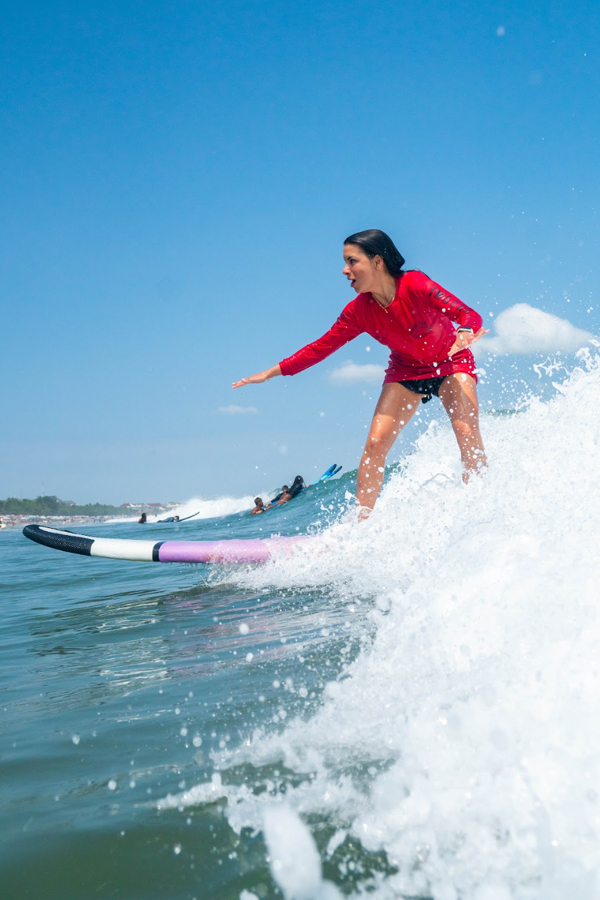How to Choose the Right Surfboard: Ultimate 2026 Guide

How to Choose the Right Surfboard: Ultimate 2026 Guide
Walking into a surf shop or browsing online boards can feel overwhelming. With hundreds of shapes, sizes, and designs all claiming to be “the perfect board,” how do you actually choose the right surfboard for your specific needs?
The truth is, there's no single “best” surfboard—only the best surfboard FOR YOU. As coaches at Sōleïa Surf Camp, we've helped thousands of surfers find their perfect match. The right board will accelerate your progression and increase your stoke, while the wrong one can lead to frustration and plateaus.
This comprehensive guide will walk you through the exact process we use with our students to match them with their ideal equipment.
Table of Contents
ToggleThe 5 Key Factors in Choosing Your Surfboard
1. Your Skill Level (The Most Important Factor)
Your experience level dramatically impacts what board you should be riding:
Beginner Surfers (0-6 months)
- What to look for: Maximum stability and forgiveness
- Recommended boards: Soft-top funboards or longboards
- Ideal dimensions: 8′-9′ long, 22″-23″ wide, 3″+ thick
- Why it works: Extra volume helps with paddling, catching waves, and stability while learning
Intermediate Surfers (6 months – 2 years)
- What to look for: A balance of paddle power and maneuverability
- Recommended boards: Funboards, hybrids, fish shapes
- Ideal dimensions: 7'0″-7'6″ long, 21″-22″ wide, 2 3/4″-3″ thick
- Why it works: Enough float for paddling but responsive for turning
Advanced Surfers (2+ years)
- What to look for: Performance and responsiveness
- Recommended boards: Shortboards, performance hybrids, step-ups
- Ideal dimensions: Custom based on weight, skill, and wave types
- Why it works: Maximum maneuverability for critical surfing
2. Your Body Type & Weight
Volume is your best friend when learning to choose the right surfboard. Here's a simple starting point:
| Weight Range | Beginner Volume | Intermediate Volume | Advanced Volume |
|---|---|---|---|
| < 68 kg (150 lbs) | 55-65L | 45-55L | 25-35L |
| 68-82 kg (150-180 lbs) | 65-75L | 55-65L | 28-38L |
| 82-95 kg (180-210 lbs) | 75-85L | 65-75L | 32-42L |
| 95+ kg (210+ lbs) | 85L+ | 75L+ | 35L+ |
3. Your Local Wave Conditions
The waves you typically surf should heavily influence choose the right surfboard:
Small/Mushy Waves (1-3 ft)
- Best board types: Fish, hybrid, high-volume shortboard
- Key features: Extra width, thickness, and flat rocker
- Why it works: More volume helps generate speed in weak waves
Average Beach Break (2-5 ft)
- Best board types: All-rounder shortboard, hybrid, funboard
- Key features: Moderate rocker, balanced dimensions
- Why it works: Versatile enough for most common conditions
Powerful/Barreling Waves (4 ft+)
- Best board types: Performance shortboard, step-up, gun
- Key features: More rocker, narrower outline, pulled-in nose
- Why it works: Handles speed and maintains control in critical sections
4. Your Surfing Goals
What type of surfing do you want to do?
- Learning basics: Prioritize stability over everything
- Progressing to turns: Look for a board that turns easily
- High-performance: Focus on responsiveness
- Wave count: Choose volume for more waves caught
5. Your Fitness & Age
- High fitness: Can handle lower volume boards
- Average fitness: Stick to moderate volume
- Older surfers/Lower fitness: Benefit from extra volume and length
- Injuries/limitations: Consider wider, thicker boards for stability
Surfboard Types Explained
The Major Surfboard Categories
Longboards (9'+)
- Best for: Beginners, small waves, classic style
- Pros: Easy paddling, stable, catch everything
- Cons: Difficult to turn in critical sections
- Ideal conditions: 1-4 ft, mushy waves
Funboards/Midlengths (7'6″-8'6″)
- Best for: Beginners to intermediates, transition boards
- Pros: Good paddle power, easier to turn than longboards
- Cons: Not high-performance, limited in big waves
- Ideal conditions: 2-5 ft, most wave types
Fish (5'6″-6'8″)
- Best for: Intermediate to advanced, small wave specialists
- Pros: Fast, loose, great in weak waves
- Cons: Less control in powerful waves
- Ideal conditions: 1-4 ft, mushy surf
Hybrids (6'4″-7'2″)
- Best for: Intermediate surfers, all-around performance
- Pros: Versatile, user-friendly, good wave range
- Cons: Not specialized for any particular condition
- Ideal conditions: 2-6 ft, most wave types
Shortboards (5'10”-6'4″)
- Best for: Advanced surfers, performance surfing
- Pros: Highly maneuverable, responsive, good in barrels
- Cons: Difficult to paddle, less forgiving
- Ideal conditions: 3-8 ft, quality waves
Step-ups/Guns (6'6″-7'6″+)
- Best for: Advanced surfers, big waves
- Pros: Paddle power, control at high speeds
- Cons: Difficult to turn in small waves
- Ideal conditions: 6 ft+, powerful waves
Bali-Specific Board Recommendations
Matching Your Board to Bali's Waves
Beginner Breaks (Kuta, Seminyak, Sanur)
- Recommended boards: Soft-tops, funboards, longboards
- Volume range: High volume (65L+ for average weight)
- Why it works: Sandy bottoms forgive mistakes, mushy waves need paddle power
Intermediate Breaks (Canggu, Balangan, Dreamland)
- Recommended boards: Hybrids, fish, funboards
- Volume range: Medium-high volume (45-65L for average weight)
- Why it works: Mix of reef and sand bottoms, varying wave power
Advanced Breaks (Uluwatu, Keramas, Padang Padang)
- Recommended boards: Performance shortboards, step-ups
- Volume range: Lower volume (25-35L for average weight)
- Why it works: Powerful, barreling waves need responsive equipment
Seasonal Considerations in Bali
- Dry season (Apr-Oct): Bigger swells may require step-up boards
- Wet season (Nov-Mar): Smaller waves ideal for fish and hybrids
- Year-round quiver: Most surfers need 2-3 boards for Bali's varying conditions
Common Mistakes When Choosing a Surfboard
What to Avoid
- Choosing Based on Pros: Don't buy a board because your favorite pro rides it
- Too Much Too Soon: Don't downsize before you're ready
- Ignoring Volume: Volume matters more than length alone
- One-Board Quiver: Bali's varying conditions often require multiple boards
- Used Board Pitfalls: Check for delamination, yellowing, and serious pressure dings
Rental vs. Buying in Bali
| Option | Pros | Cons | Best For |
|---|---|---|---|
| Renting | Try different shapes, no maintenance, affordable short-term | Limited selection, quality varies, expensive long-term | Visitors (1-2 weeks), beginners |
| Buying New | Perfect fit, quality construction, long-term investment | Higher upfront cost, maintenance required, commitment | Residents, long-term visitors, serious surfers |
| Buying Used | Affordable, immediate availability, Bali has great selection | Unknown history, potential damage, may not be perfect fit | Budget-conscious, intermediate+ surfers |
FAQ: Choosing the Right Surfboard
For beginners, $400-600 for a new soft-top or $200-400 for a used funboard. Don't overspend—your first board won't be your last.
When you're catching 80%+ of waves you paddle for, making basic turns, and feel limited by your board's maneuverability.
They all matter, but volume (determined by all three) is the most important metric. Use volume as your primary guide.
For trips under 3 months, consider renting or buying used in Bali. The selection is excellent and you avoid airline fees.
Beginners need one. Intermediates benefit from 2-3 (small wave board, all-rounder, step-up). Advanced surfers often have 3-5+ specialized boards.
A hybrid or fish in the 6'4″-7'0″ range works well for most conditions and skill levels.
Depending on use, every 1-3 years. Look for yellowing, delamination, or lots of serious dings as signs it's time for replacement.
Conclusion: Your Perfect Board Awaits
Learning how to choose the right surfboard is a journey that evolves with your surfing. The board that felt perfect six months ago might be holding you back today. Remember that the best surfer in the water isn't the one with the most expensive equipment—it's the one having the most fun and catching the best waves.
When in doubt, err on the side of more volume rather than less. It's better to have a board that's slightly too big than one that's too small. And don't be afraid to ask for help—visit local surf shops, talk to experienced surfers, and consider professional coaching to get personalized recommendations.
At Sōleïa Surf Camp, we include board recommendations as part of all our coaching programs because we've seen how the right equipment can transform a surfer's progression and enjoyment.
Recent Posts
How to Choose the Right Surfboard: Ultimate 2026 Guide
Intermediate Surfer Skills: 7 Key Areas to Master Next
Surf Levels: How to Understand Where You Are with Your Surfing
Start From € 5125,-
Our 12-weeks
Surf Academy Program in Bali




